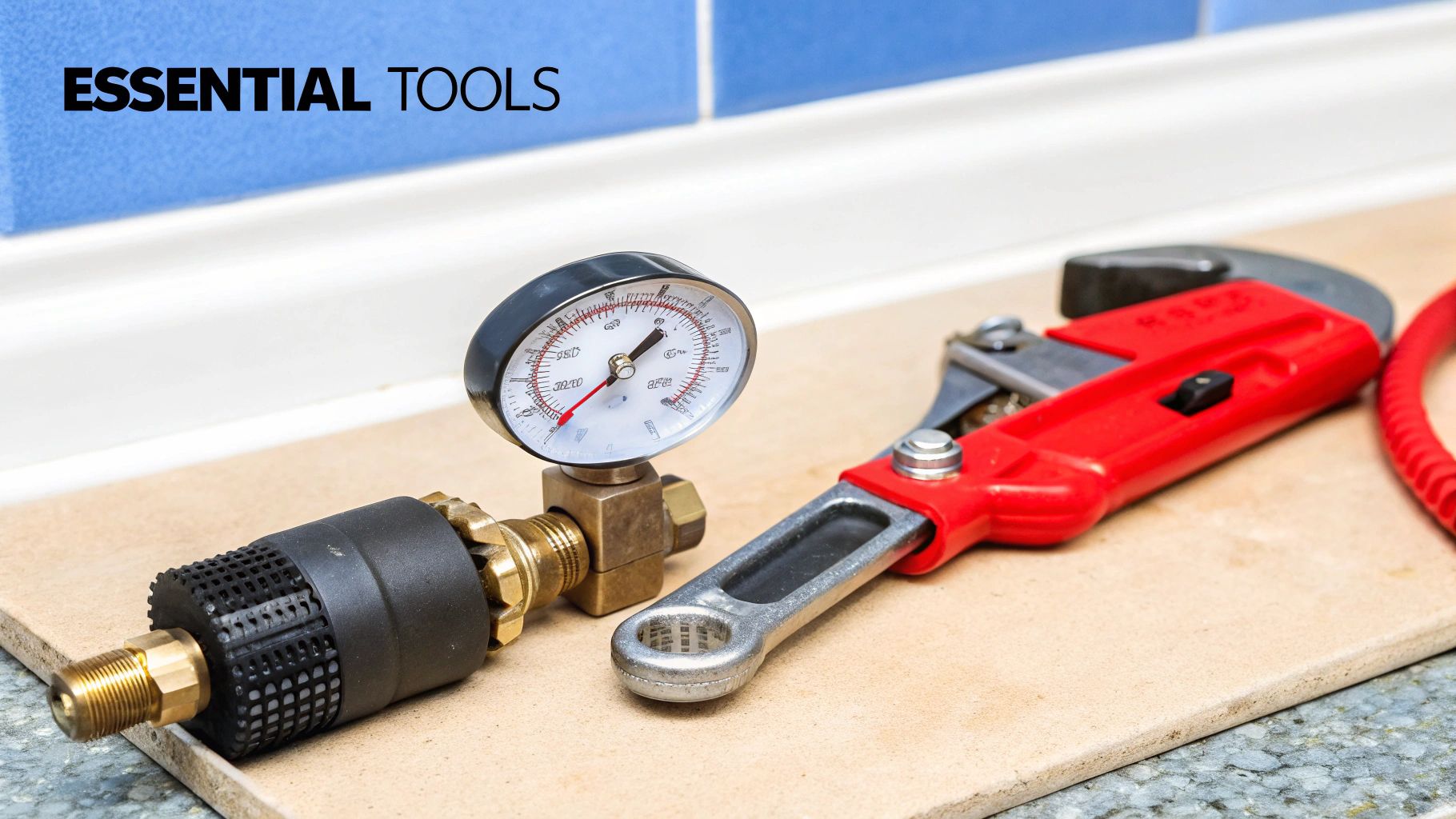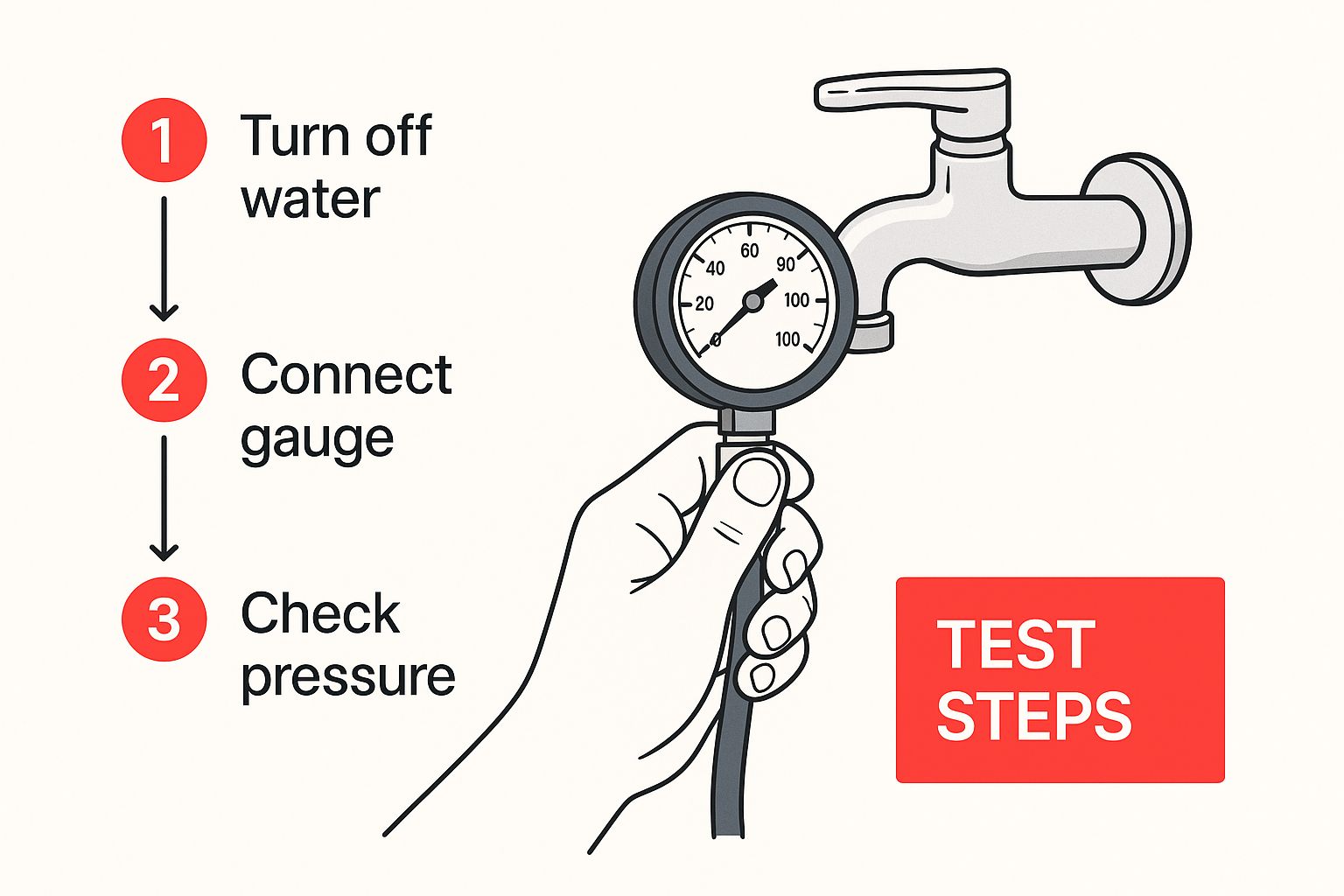Testing your home's water pressure is one of the easiest and most important diagnostic checks a property owner can perform. It takes just a few minutes, requires an inexpensive tool, and gives you a clear PSI (pounds per square inch) reading. This single number tells you whether your plumbing is operating in a safe, efficient range, which is critical for preventing costly damage for homeowners and businesses in Oxnard.
Knowing your home's PSI is the first step toward preventing some seriously expensive pipe damage and improving the performance of your entire plumbing system.
Why Getting Your Water Pressure Right Matters
Think of your home's water pressure like the blood pressure in your body: it needs to be just right. Too high or too low, and you've got problems. For property owners, especially here in Ventura County, finding that sweet spot is key to daily comfort and avoiding a plumbing nightmare.
When the pressure is off, you'll feel it everywhere. Too low, and your shower becomes a weak, frustrating drizzle. Simple things like rinsing dishes or filling a pot of water suddenly take forever.
But it's the other side of the coin that's truly dangerous. Excessively high water pressure puts a constant, relentless strain on every single pipe, joint, and appliance in your home. It's a silent problem that can cause a world of trouble, often leading to emergency plumbing situations that require immediate attention.
Telltale Signs of a Pressure Problem
High pressure isn't just a minor annoyance; it’s an active threat to your plumbing. Keep an eye (and an ear) out for these warning signs:
- Banging Pipes: That loud thump or knocking sound when a faucet shuts off? That's called a water hammer, and it's a classic sign of pressure that's way too high.
- Dripping Faucets: A constant drip isn't just a waste of water; it's a sign your fixtures are losing the battle against intense pressure. This can often be solved with simple pipe repair, but the underlying pressure issue must be addressed.
- Failing Appliances: High pressure can destroy the internal components of your dishwasher, washing machine, and especially your water heater, leading to premature breakdowns and the need for water heater repair.
- Burst Pipes: This is the worst-case scenario. Constant high pressure can lead to a catastrophic pipe burst, causing major water damage and a huge mess.
Pro Tip: Don't dismiss low water pressure as just a neighborhood issue. If it comes on suddenly and stays low, it could be an early warning sign of a hidden leak somewhere on your property.
A lot of common household annoyances are actually symptoms of a pressure problem. Here's a quick way to connect the dots:
Quickly Spotting Water Pressure Problems
| Symptom You Notice | What It Could Mean (Low Pressure) | What It Could Mean (High Pressure) |
|---|---|---|
| Weak shower stream | Not enough force to push water through the showerhead effectively. | N/A |
| Banging or noisy pipes | N/A | A "water hammer" effect from water stopping too abruptly. |
| Faucets drip constantly | N/A | Seals and washers are wearing out under constant strain. |
| Dishwasher or clothes washer takes forever to fill | The machine isn't getting water fast enough to run its cycle. | N/A |
| Water heater makes popping noises | N/A | Pressure is forcing water through sediment buildup inside the tank. |
Understanding these symptoms is the first step in smart home maintenance. An imbalance often points to a deeper issue. For instance, consistently low pressure with no other explanation is a huge red flag for a hidden leak, which is a common issue our expert team serving Ventura County sees all the time.
You can learn more about how we pinpoint these sneaky problems in our guide to professional leak detection. A simple pressure test is a powerful tool that puts you in control, letting you protect your home before a small problem turns into a disaster.
Just One Simple Tool Gets the Job Done

Good news. You don't need to haul out a giant toolbox for this job. The only thing standing between you and knowing your home's water pressure is one simple, inexpensive gadget: a water pressure test gauge.
Seriously, that's it. It’s not some fancy, complicated piece of plumbing equipment. You can pick one up at any hardware store here in Oxnard or around Ventura County, usually for less than $15. It’s a small investment that delivers huge peace of mind about your plumbing's health.
When you’re browsing the aisle, grab a gauge with a dial that reads up to at least 200 PSI. This ensures you have more than enough range to get an accurate measurement. A lot of these gauges also come with a handy little marker you can use to track the highest reading, which is a nice feature.
A Few Things to Make It Even Smoother
While the gauge is the star of the show, a couple of other items can make the test completely foolproof.
- Thread Seal Tape: You might know this as plumber's tape. A quick wrap around the spigot's threads before you attach the gauge will guarantee a perfect, leak-free seal. No drips, no skewed results.
- A Pair of Gloves: This is purely for comfort. It just keeps your hands clean and dry while you're working with the outdoor faucet.
At Armor Hydro Jetting, our goal is to empower you. Taking five minutes to run this simple test can save you from a frantic call to us for a burst pipe or a major plumbing emergency. It’s genuinely one of the smartest preventative checks you can do as a homeowner.
How to Test Water Pressure in Five Minutes
Ready to find out what your home's water pressure is? Let's get right to it. This whole process is surprisingly quick and straightforward, and it gives you a crucial piece of information about your plumbing's health.
First things first, you need to create what plumbers call a "static" pressure environment. That's just a technical way of saying you need to make sure no water is running anywhere inside or outside your house. So, double-check that the dishwasher, washing machine, sprinklers, and every single faucet are completely off.
Finding the Right Spot and Getting Set Up
Now, you need to find the best place to attach your pressure gauge. For most homes, the perfect spot is an outdoor hose spigot (sometimes called a hose bibb). If you know where your water main enters your property, try to use the spigot closest to that point; it will give you the most accurate reading of the pressure coming into your home.
Take a quick look at the threads on the spigot. If they're a bit grimy, give them a quick wipe with a rag to ensure a tight seal. Then, just screw the pressure gauge on by hand until it's snug. No need to break out the wrench for this; hand-tight is all you need.
This quick visual guide breaks down just how simple the test really is.

As you can see, it really is as easy as connecting the gauge and turning on the water.
Taking the Reading
Here we go, the moment of truth. Turn the spigot handle all the way to open it fully. You'll see the needle on your gauge jump and then settle firmly on a number. That number is your home's static water pressure, measured in PSI (pounds per square inch).
Jot that number down. If you want to be extra thorough, you can repeat the test on another spigot on a different side of your house. If you see a big difference between the two readings, it could be a clue that there's an issue somewhere within your home's plumbing.
Professionals take pressure testing very seriously to guarantee a system's safety. The industry-standard formula for a hydraulic test is to pressurize the system to 1.5 times its maximum working pressure. This builds in a critical safety margin. You can learn more about professional pipework testing methods and why that safety factor is so vital.
Once you have your number, just turn the spigot off and unscrew the gauge. That’s it! You've successfully tested your water pressure and now have a key insight into your plumbing system.
What Your Water Pressure Numbers Actually Mean
Alright, you've got your PSI reading. Now, what does that number really say about the health of your home's plumbing? Think of it like a "Goldilocks zone." For most of us here in Ventura County, that sweet spot is somewhere between 45 and 60 PSI.
This is the ideal range: strong enough to give you a satisfying shower but not so forceful that it puts your pipes and appliances under constant stress. If your gauge landed in this zone, you can probably breathe a sigh of relief. Your system is likely in great shape.
But if your number is outside that range, don't ignore it. It’s an early warning sign, and catching it now can save you from a much bigger headache down the road.
Pressure Too Low? Here's What to Look For
Did your gauge show a reading below 40 PSI? That explains the weak shower and the washing machine that takes forever to fill. It’s classic low water pressure.
Before you jump to the worst-case scenario, do a quick check of the simple stuff. Is the main shutoff valve to your house open all the way? Sometimes it's that easy.
If the simple fixes don't move the needle, you might be looking at a more hidden issue. Low pressure can be a symptom of a hidden leak, old pipes that are clogged with corrosion, or even a problem with the city's water main. We dive deeper into tracking down the source in our complete guide to solving low water pressure.
By the way, the test you just performed is a basic form of hydrostatic testing. It’s what we pros use because it’s incredibly safe and reliable. Water doesn't compress like air, so there's far less stored energy, making it the industry standard for a reason. You can learn more about the science behind pressure testing methods and why it's trusted by experts.
The Problem With Pressure That's Too High
Now, let's talk about the other side of the coin. If your gauge shot up past 80 PSI, that’s a serious red flag. You're in the danger zone.
That kind of extreme force is like a constant battering ram against every part of your plumbing system. It wears down faucet seals, stresses washing machine hoses until they burst, and can even slash the lifespan of your water heater. It's a recipe for an emergency plumbing call.
For homes in Oxnard and the surrounding areas dealing with high pressure, the fix is usually a Pressure Reducing Valve (PRV). This little device gets installed where your water line enters the house and acts like a gatekeeper, stepping down the intense pressure from the city main to a safe level for your home.
When to Call a Ventura County Plumbing Expert

While a pressure gauge gives you a vital piece of information, it doesn't tell the whole story. Your DIY test is a fantastic first step, but actually fixing the root cause? That often takes a pro with the right tools and years of experience. Knowing when to put the gauge down and pick up the phone is key to protecting your home in Oxnard from some serious, and often expensive, damage.
If your test shows dangerously high pressure, anything over 80 PSI, it’s time to call a professional right away. On the flip side, if you've got frustratingly low pressure and have already double-checked that your main shutoff valve is wide open, you're likely dealing with a bigger issue. These aren't problems you can ignore or solve with a quick tweak.
Finding the Real Problem
At Armor Hydro Jetting, we dig deeper than just a simple gauge reading. Our team uses advanced diagnostic tools to pinpoint the exact source of your water pressure woes. The culprit could be anything from a failing pressure-reducing valve to a hidden pinhole leak in a pipe buried deep inside a wall.
A thorough diagnosis is absolutely critical. That’s why we often recommend a full professional inspection to get the complete picture of your plumbing’s health. You can learn more about what our comprehensive plumbing inspection services in Oxnard involve.
For over 50 years, professional plumbers have used hydrostatic testing to confirm a plumbing system is sound. This involves pressurizing pipes to 1.5 times their normal working limit to guarantee they are leak-free and built to last. It’s a trusted industry standard for a reason.
Sometimes, the cause of low pressure isn't a leak at all but years of mineral and gunk buildup that's literally choking your pipes. In those situations, our powerful hydro jetting service can scour the lines clean, restoring flow and pressure without harming your plumbing. Trusting an expert in Ventura County not only gets the job done right but gives you lasting peace of mind.
Whether you're dealing with pressure that's too high, too low, or all over the place, the team at Armor Hydro Jetting has seen it all. We have the expertise to solve the problem safely and for good. We provide lasting solutions for everything from simple drain cleaning to heavy-duty hydro jetting and pipe repair. For a professional diagnosis and real peace of mind in Ventura County, visit us online to schedule your service.
